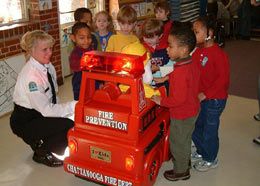 Photo courtesy of Chattanooga, Tenn., Fire Department. A fire prevention officer enlists the help of Sparky the Fire Dog to spread the word about fire safety to children. |
I recently read an e-mail article from one of the more innovative, forward thinkers of the fire service — Chief Billy Goldfeder. He is a tireless advocate of eliminating line-of-duty deaths and injuries and I, as a former line firefighter, really respect everything he has done toward that end.
In this article, he highlighted the need to continue to reduce all unnecessary LODDs and injuries and made several observations on how we could accomplish this, citing 12 steps on the IAFC Safety, Health and Survival website.
The chief hit just about every possible solution and all encompassed the NFFF’s Everyone Goes Home 16 Firefighter Life Safety Initiatives, except for one — #14: Public education must receive more resources and be championed as a critical fire and life safety program.
Needless to say, as a life safety educator, I was extremely disappointed to find no mention of the critical role life safety education can play in the reduction of LODDs and injuries. Let me be blunt: If we educate folks to not start fires, and thus reduce the number of fire incidents, we will not be sending firefighters to fires where they can become hurt or, worse, killed. Every time a fire engine or ambulance goes out its doors on an emergency response is an opportunity, in my view anyway, for someone to not go home.
While I simplified the issue above, as there are other causes of death and injury that do not necessarily relate to fires, the fact remains that this particular component of the 16 Life Safety Initiatives is largely ignored and not even acknowledged by the vast majority of the fire service.But why?
Staffing levelsAre we afraid that we will be putting ourselves out of business? Afraid that local politicians will take the fourth person from an engine company and assign him/her to public education duties, thus losing the valued four-person minimum staffing level?
Whatever the reason, one thing is very clear to me — public education, for the vast majority of the fire service, does not receive appropriate resources and is not championed as a critical program. There are very few fire chiefs across the country right at this very moment who can claim otherwise. They may talk the talk, but when it’s the time to walk the walk they do not — period.
As many of us are all too painfully aware, budget times are rough again. Fire and injury prevention staffing and programs, as has happened before, are bearing the brunt of this reduced funding.
The ugly fact of the matter is that we, as a fire service, are a reactive and not proactive entity. When someone has to call 9-1-1 to report their home on fire, we should view this as a potential failure on our part. After all, many departments around the country have some form of the word prevention and education in their mission and/or vision statements. Heck, many firefighter job descriptions have prevention and/or public education listed as a job responsibility.
Yet, proactive public education staffing and programs are treated more as an afterthought by a majority of the fire service. As one of my colleagues so astutely observed: fire and injury prevention education is to the fire service what music and arts programs are to the school systems. In other words, we’ll minimally fund and staff you when we can and look to cut and reduce you when times are tough. It all stems down to the fact that this area is really not viewed as a necessity or as an important, part of the overall fire service mission.
I am not suggesting that we close fire stations or reduce staffing all in the name of public education. What I am suggesting is that it needs to be an equal partner and viewed as such in the U.S. fire service family. Because of folks such as Chief Ron Siarnicki of the NFFF, Chief Goldfeder and many others too numerous to mention, we are beginning to ride a wave of positive cultural change in the fire service. My great fear is that a critical component of this — public education — is currently not on the surf board riding this wave and that is a very tragic mistake.

